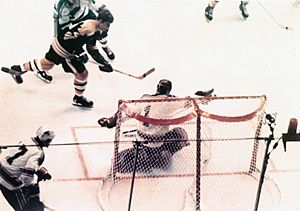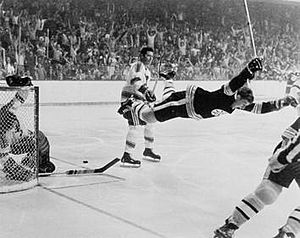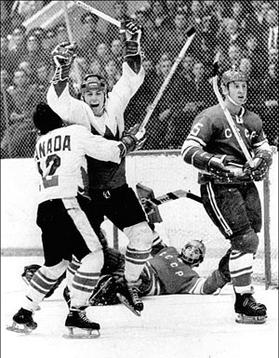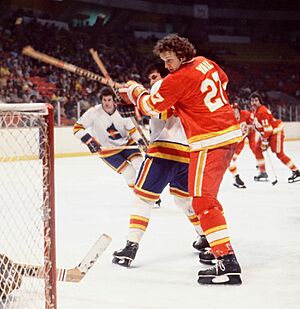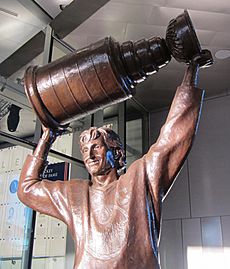History of the National Hockey League (1967–1992) facts for kids
The expansion era of the National Hockey League (NHL) began in the 1967–68 season when six new teams joined the league. This ended the time when only six teams, known as the Original Six, played in the NHL. The original six teams were put into the new East Division. The new teams – the Los Angeles Kings, Minnesota North Stars, Oakland Seals, Philadelphia Flyers, Pittsburgh Penguins and St. Louis Blues – formed the West Division.
The NHL kept growing, adding six more teams by 1974, making it 18 teams in total. This growth was partly because of a new league called the World Hockey Association (WHA). The WHA operated from 1972 to 1979 and tried to compete with the NHL for cities and players. Bobby Hull was the most famous player to leave the NHL for the WHA, signing a huge contract with the Winnipeg Jets. When the WHA stopped playing in 1979, the NHL welcomed four of its teams: the Edmonton Oilers, Hartford Whalers, Quebec Nordiques and Winnipeg Jets. This brought the NHL to 21 teams. The Cleveland Barons had stopped playing in 1978. The number of teams stayed at 21 until the San Jose Sharks joined in 1991.
The NHL also started playing more international games. The first big event was the Summit Series in 1972. This series matched the best Canadian NHL players against the top players from the Soviet Union. Canada won the eight-game series with four wins, three losses, and one tie. The success of this series led to the Canada Cup, which was held five times between 1976 and 1991. NHL teams also played against Soviet League teams that toured North America from 1975 to 1991 in what was called the Super Series. After the fall of the Iron Curtain in 1989, many players from former Soviet countries joined the NHL.
This time was also the highest-scoring period in NHL history. In the 1980s, the Edmonton Oilers and Wayne Gretzky led the way. Gretzky scored 200 points or more four times, including a record 215 points in 1985–86. His 92 goals in 1981–82 is still a league record. No other player has scored 200 points in a season, though Mario Lemieux came close with 199 points in 1988–89.
Contents
How the NHL Grew
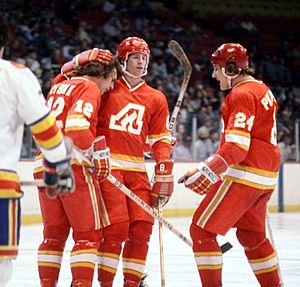
NHL owners had been talking about adding new teams since 1963. They worried that another league, the Western Hockey League, might try to become a major league. In February 1966, the NHL announced it would add six new teams, doubling its size.
The Los Angeles Kings, Minnesota North Stars, California Seals, Philadelphia Flyers, Pittsburgh Penguins and St. Louis Blues started playing in the 1967–68 season. These new teams formed the West Division. The existing teams were put into the East Division. The playoff rules were set up so that an older team would play a new expansion team in the Stanley Cup Finals. The Clarence S. Campbell Bowl trophy was created for the West Division champion.
The new teams got their players through the NHL's first expansion draft. Each new team picked 20 players from the existing teams. There was a lot of discussion about how many players each original team could protect. Stronger teams wanted to protect more players, while weaker teams hoped that protecting fewer players would help make the league more balanced. They agreed that teams could protect eleven players at first. Then, they could add one more protected player for each player chosen in the draft.
After the 1968 and 1969 seasons, an "intra-league draft" was held. This helped the new teams get better faster. Teams protected two goalies and fourteen skaters, and other players could be picked by any other team.
Some teams bought existing minor league teams to create their own farm systems. The Kings bought the Springfield Indians of the American Hockey League. The Flyers then bought the Quebec Aces. Expansion also changed how the amateur draft worked. By 1969, the old system, where teams sponsored junior players, was stopped. All junior-aged players became eligible for the entry draft.
Early Expansion Years
In their first season, the Flyers finished first in the West Division. The California Seals changed their name to the Oakland Seals a month into the season. They didn't play well and finished last in the NHL. The Blues became the first expansion team to play for the Stanley Cup. They lost to the Canadiens in four games. The Blues reached the finals again in 1969 and 1970, but lost both times.
On January 13, 1968, North Stars rookie Bill Masterton was seriously injured during a game. He was checked hard and landed on his head. He died two days later. The National Hockey League Writers Association created the Bill Masterton Memorial Trophy in his honor. This trophy is given each year to a player who shows great determination and dedication to hockey. After Masterton's death, players slowly started wearing helmets. Starting in the 1979–80 season, the league made it mandatory for all new players to wear them.
Bobby Orr's Impact
In the 1968–69 season, second-year defenseman Bobby Orr scored 21 goals. This was a new NHL record for a defenseman. He went on to win eight Norris Trophies in a row as the league's best defenseman. At the same time, Orr's teammate, Phil Esposito, became the first player to score 100 points in a season, finishing with 126 points.
Bobby Orr was a fantastic scorer. He changed how defensemen played, showing that they could be great at creating goals, not just stopping them. In 1970, Orr scored the Stanley Cup-winning goal in overtime against the Blues. This gave the Bruins their first championship in 29 years. His goal is famous for him flying through the air after being tripped. Orr won the Art Ross Trophy twice as the NHL's top scorer. He is still the only defenseman to do this. His plus/minus of +124 in 1970–71 is a league record. In 1971, Orr signed a five-year contract for $200,000 per season, which was the first $1 million contract in league history.
Orr had many knee problems throughout his career. In 1972, he tore ligaments in his left knee, leading to the first of six knee surgeries. He played 12 seasons in the NHL before injuries forced him to retire in 1978. Orr finished with 270 goals and 915 points in 657 games. He won the Hart Memorial Trophy three times as the league's Most Valuable Player. He was put into the Hockey Hall of Fame in 1979, without the usual three-year waiting period.
More Teams Join
Many Canadians were upset when Vancouver didn't get an expansion team in 1967. Three years later, the NHL added a third Canadian team. The Vancouver Canucks, from the Western Hockey League, joined for the 1970–71 season. The Buffalo Sabres also joined. The Canucks were placed in the East Division, even though they were on the west coast. The Chicago Black Hawks moved to the West Division to balance the teams.
The league also gave the Sabres and Canucks the first two picks in each round of the 1970 NHL Amateur Draft. This helped them build their teams faster than the 1967 expansion teams. Buffalo's first pick was Gilbert Perreault, who would play 17 seasons in Buffalo and become a Hall of Famer.
Before the 1971–72 season, Gordie Howe and Jean Beliveau retired. Beliveau finished his 18-year career with 10 Stanley Cups and 1,219 points. Howe retired after 25 seasons as the league's all-time leader in games played, goals, assists, and points. Both players were put into the Hockey Hall of Fame without the usual waiting period because of their amazing achievements.
The WHA Challenge
In 1972, the NHL faced a new rival: the World Hockey Association (WHA). The WHA attracted many players from the NHL, including Derek Sanderson and J. C. Tremblay. The WHA's biggest move was getting Bobby Hull from the Black Hawks to play for the Winnipeg Jets. Hull signed a 10-year deal worth $2.7 million, which included a $1 million signing bonus. This deal made the new league seem very serious. After Hull signed, many other players followed. By the time the 1972–73 WHA season began, 67 players had moved from the NHL to the WHA. Even Gordie Howe came out of retirement to play with his sons, Mark and Marty, for the Houston Aeros.
The NHL tried to stop some players from leaving. The Bruins tried to prevent Gerry Cheevers and Derek Sanderson from joining the WHA. However, a U.S. federal court allowed the signings. The Black Hawks did get a court order against Hull and the Jets. But in November 1972, a court stopped the NHL from enforcing its "reserve clause." This clause tied a player to their NHL team until the team released them. This decision meant that players like Hull were free to play for WHA teams. It effectively ended the NHL's complete control over professional hockey players.
The NHL also had to compete with the WHA for cities. The NHL had not planned to expand beyond 14 teams. But the WHA's threat changed this. To keep the WHA out of new arenas in Uniondale, New York and Atlanta, Georgia, the NHL quickly added the New York Islanders and Atlanta Flames as expansion teams in 1972. After the 1972–73 season, the NHL announced it would expand again to 18 teams for the 1974–75 season. They added the Kansas City Scouts and Washington Capitals. In just eight years, the NHL had tripled in size to 18 teams.
Summit Series
For a long time, Canada had complained about the Soviet Union using "professional amateurs" in amateur events like the World Championships and the Olympic Games. Canada stopped playing in international competitions in 1969 and boycotted the 1972 Olympic hockey tournament. As a solution, NHL Players' Association executive director Alan Eagleson arranged an eight-game series between the Soviet national team and Canada's top professional players.
The NHL used this tournament to respond to players leaving for the WHA. Bobby Hull and other players who signed with the WHA were not allowed to play. This decision was heavily criticized. Even Prime Minister Pierre Trudeau sent a telegram to NHL president Clarence Campbell, saying that Canada should be represented by its best players, including Bobby Hull. Hull himself called the decision "crazy" and said he wanted to play for his country. But the NHL did not change its mind.
The series was tied at three wins each and one tie going into the eighth and final game. Millions of Canadians watched "the game of the century." With the game tied late in the third period, Canada attacked hard. With 34 seconds left, Paul Henderson scored the winning goal, making it 6–5 for Canada. This won the series for Canada. Later, Alexander Yakolev, a former Soviet ambassador, said the Summit Series helped start changes in the Soviet Union. It was one of the first times Soviet people saw many foreigners who came to share in the game, not to cause harm.
Series Legacy
The Summit Series made the NHL and Canadian hockey rethink how the game was played in North America. Journalist Herb Pinder said that before the series, "The Europeans took our game and evolved it, while we stood still." After the series, Canadian hockey started using new coaching and training methods from Europe. They focused more on fitness and skill development.
The NHL became more interested in international play. The Canada Cup, a tournament with the world's top professional players, was first held in 1976. It was held four more times until 1991. It was later replaced by the World Cup of Hockey in 1996. Starting in 1975, Soviet club teams toured North America, playing exhibition games against NHL clubs. These were called the Super Series. The Calgary Flames and Washington Capitals also toured the Soviet Union in 1989 in the first "Friendship Series."
The 1970s
Broad Street Bullies
The 1970s were known for aggressive and often violent play. The Philadelphia Flyers, known as the "Broad Street Bullies," are the most famous example of this style. The Flyers set league records for penalty minutes. Dave "the Hammer" Schultz had 472 penalty minutes in 1974–75, which is still a league record. The Flyers even ended up in court multiple times when players went into the stands to confront fans. Despite these incidents, the Flyers won the 1974 Stanley Cup, becoming the first expansion team to win the championship. They won again in 1975.
In 1975, Soviet club teams began touring North America in the first Super Series. The Canadiens played Central Red Army to a 3–3 tie on New Year's Eve 1975. This game is considered one of the best ever played. Red Army lost only one of four games against NHL teams in that first tour. That loss was a 4–1 defeat to Philadelphia, who used their intimidating style against them. Super Series games continued until 1991, when Soviet players were allowed to join the NHL after the collapse of the Soviet Union.
End of Two Leagues
On February 7, 1976, Maple Leafs star Darryl Sittler set an NHL record by scoring 10 points in one game. He had six goals and four assists in an 11–4 win over the Bruins.
By 1976, both the NHL and WHA were having serious money problems. Talks about merging the two leagues grew. In 1976, for the first time in 40 years, the NHL allowed teams to move. The Scouts moved from Kansas City to Denver to become the Colorado Rockies. The California Golden Seals became the Cleveland Barons. Two years later, after failed attempts to merge the Barons with other teams, they merged with the Minnesota North Stars. This reduced the NHL to 17 teams for 1978–79.
The WHA's last big success was signing young star Wayne Gretzky in 1978–79. Gretzky, who was 17, scored 110 points in his first professional season, playing for the Indianapolis Racers and the Edmonton Oilers.
The move towards a merger gained speed in 1977 when John Ziegler became NHL president. After several years of talks, WHA owners thought they had a deal in March 1979. But the vote to merge failed in the NHL by one vote. It was rumored that the Montreal Canadiens and Vancouver Canucks had voted against it. Fans across Canada started boycotting products from Molson Brewery, which owned the Canadiens. The House of Commons even passed a motion urging the NHL to reconsider. Another vote was held, and both Montreal and Vancouver changed their votes, allowing the merger to pass. The WHA stopped playing after the 1978–79 season. The Edmonton Oilers, New England Whalers, Quebec Nordiques and Winnipeg Jets joined the NHL as new teams.
Twenty-one Teams
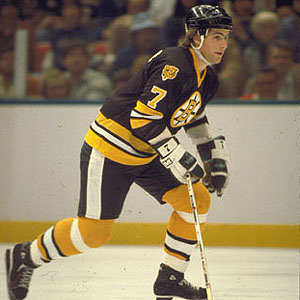
The merger brought Gordie Howe back to the NHL for one last season in 1979–80. At 51 years old, Howe played all 80 games for the Whalers. He scored 15 goals, bringing his NHL career total to 801. He retired for the second time as the league's all-time scoring leader with 1,850 points.
Howe's final season was also the last for the Atlanta Flames. The team moved north to become the Calgary Flames in 1980–81. Two years later, the Rockies moved from Denver to become the New Jersey Devils for the 1982–83 season.
In 1980, the New York Islanders won their first of four Stanley Cups in a row. With players like Billy Smith, Mike Bossy, Denis Potvin, and Bryan Trottier, the Islanders were dominant. In 1981, Bossy became the first player since Maurice Richard in 1945 to score 50 goals in 50 games. In 1982–83, the Edmonton Oilers won the regular season championship. The Islanders and Oilers met in the Finals, and New York swept Edmonton for their last Stanley Cup. They were the second team to win four straight championships, after the Canadiens.
The next season, the Oilers and Islanders met again in the playoffs. The Oilers won this time in five games, starting their own dynasty. Led by Wayne Gretzky and Mark Messier, the Oilers won five Stanley Cup championships between 1984 and 1990. The Oilers won two Cups in a row in 1983–84 and 1984–85, and again in 1986–87 and 1987–88. They also won a Cup in 1989–90.
The Oilers' Cup streaks were broken by two other Canadian teams. In 1986, the Calgary Flames defeated the Oilers after Oilers rookie Steve Smith accidentally scored an own goal. This mistake is one of the most famous blunders in hockey history. The Flames lost to the Canadiens in the finals, as rookie goalie Patrick Roy led Montreal to their 23rd Stanley Cup. The 1989 final was a rematch between the Flames and the Canadiens. Calgary won, capturing its only championship. The Flames also became the only team to defeat the Montreal Canadiens for the Stanley Cup at the Montreal Forum.
The 21-team era ended in 1990. The league announced plans to add more teams. The San Jose Sharks began playing in the 1991–92 season. The Ottawa Senators and Tampa Bay Lightning followed a year later.
Wayne Gretzky's Era
In the late 1980s, the Oilers won five Stanley Cup titles in seven years. They were the only team to score 400 or more goals in a season, which they did four times. With future Hall of Famers like Grant Fuhr, Paul Coffey, Jari Kurri, Mark Messier, and Glenn Anderson, they set many new scoring records.
The Oilers were led by Wayne Gretzky, who stayed with the Oilers when they joined the NHL in 1979. Some people doubted if Gretzky could keep up his high scoring in the NHL. But he proved them wrong, scoring 137 points in 1979–80. He won the first of nine Hart Trophies (including eight in a row from 1980 to 1988) as the NHL's most valuable player. Over the next few seasons, Gretzky set new records for goals in a season (92 in 1981–82), assists (163 in 1985–86), and total points (215 in 1985–86). He also scored 50 goals in just 39 games, the fastest any player had reached that total. Gretzky scored his 1,000th NHL point in his 424th game, breaking the old record of 720 games.
Gretzky's teammates also set records. Fuhr's 14 assists in the 1983–84 season set a record for most points by a goalie. In 1985–86, Coffey set a record for most goals by a defenseman in a season with 48.
On August 9, 1988, Oilers owner Peter Pocklington traded Gretzky to the Los Angeles Kings. This trade shocked hockey fans across Canada. Gretzky left Edmonton with a tearful news conference. He later said Edmonton was the only place he ever dreaded playing. Gretzky's move to the Kings made ice hockey much more popular in the United States.
With the Kings, Gretzky broke Gordie Howe's record for career points. On October 15, 1989, against his former Oilers teammates, Gretzky tied the record with an assist. Then he scored his 1,851st career point with a goal.
Fall of the Iron Curtain
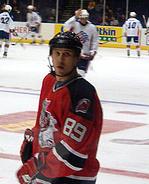
Even though European players were part of the NHL since it started, it was rare to see them until 1980. The WHA looked to Europe for talent, signing players from Finland and Sweden. Anders Hedberg, Lars-Erik Sjoberg and Ulf Nilsson signed with the Jets in 1974. They played very well in North America, first in the WHA and then in the NHL. The Jets won three WHA championships after signing European players, which encouraged other teams to sign them too.
Borje Salming was the first European star in the NHL. He signed with the Maple Leafs in 1973 and played 16 seasons in the NHL. He was inducted into the Hockey Hall of Fame in 1996. His fellow Swede, Pelle Lindbergh, was one of the best goalies in the early 1980s. Finns Jari Kurri and Esa Tikkanen helped lead the Oilers dynasty in the 1980s.
Players from behind the Iron Curtain (Eastern European communist countries) were not allowed to leave easily. In 1980, Peter Stastny, his wife, and his brother Anton secretly left Czechoslovakia with help from the Nordiques owner. The Stastnys' defection made international news. It led to the first wave of Eastern Europeans joining the NHL. Teams started drafting Soviet players in the 1980s, hoping they would one day be allowed to play. But defection was the only way for them to join. Michal Pivonka defected from Czechoslovakia in 1986. Russian Alexander Mogilny defected after a tournament in Alaska in 1989.
Just before the end of the 1988–89 regular season, Flames general manager Cliff Fletcher announced an agreement with Soviet authorities. This allowed Sergei Pryakhin to play in North America. It was the first time a Soviet national team member was allowed to play for a non-Soviet team. Soon after, Soviet players started joining the NHL. The entire "KLM" line, the Soviet team's top line, joined the NHL in 1989. Sergei Makarov won the Calder Memorial Trophy as rookie of the year in 1990. This caused some debate because he was 32 years old and had played 11 professional seasons in the Soviet League. After this, the NHL changed its rules: players over 26 were no longer considered for the rookie award. The fall of the Berlin Wall in 1989 and the end of the Iron Curtain opened the way for many more Eastern European players to play in North America.
Rules and Changes
The early 1980s had many tied games. For example, in 1982–83, 17 of 21 teams tied 10 or more games. Because of this, the NHL brought back overtime for the 1983–84 season. The effect was immediate, with far fewer ties. The modern overtime format was a five-minute, sudden-death period. The game ended when either team scored.
The NHL changed its divisions and playoff rules many times as it grew. When the league doubled in 1967, the playoffs expanded from four teams to eight. When it grew to 18 teams in 1974, the league reorganized into two conferences and four divisions. Each division was named after important people in league history. The playoffs expanded to 12 teams.
In 1981, the league grouped all teams by geography, but kept the historical division names. Eastern teams played in the Adams and Patrick divisions, and Western teams played in the Norris and Smythe divisions. The playoff format also changed. The top four teams in each division qualified, instead of the top 16 teams overall. The first two playoff rounds were played entirely within each division. This format lasted until 1993.
Entry Draft
By the late 1960s, the system of sponsoring junior players was stopped. This meant that for the 1969 NHL Amateur Draft, any player aged 20 or older could be picked. However, the Montreal Canadiens had a special "cultural option." This allowed them to pick two French-Canadian players before any other team. After the Canadiens picked Rejean Houle and Marc Tardif, the rest of the league voted to end this rule in 1970.
In 1974, Sabres general manager Punch Imlach played a joke during the draft. He picked Taro Tsujimoto of the "Tokyo Katanas" in the 11th round. Other teams were surprised that the Sabres had found a player in Japan, and the league made the pick official. Weeks later, Imlach admitted he made the player up, choosing the name from a phone book.
The league changed the Amateur Draft to the NHL Entry Draft in 1979. They also lowered the draft age to 19. It was first opened to the public in 1980, with 2,500 fans attending in the Montreal Forum. The public draft has grown and is now held in NHL arenas and shown on TV around the world.
Timeline
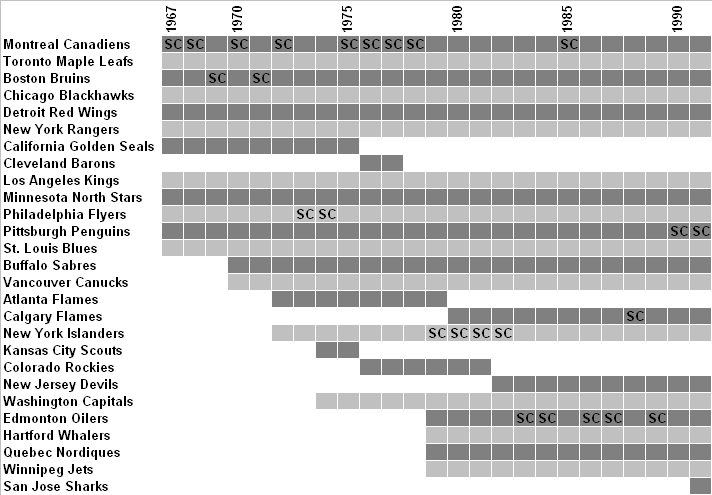
Notes
- The year given refers to the year in which that season began and not the year in which the Stanley Cup Playoffs took place
- The California Golden Seals were known as the California Seals in 1967 and as the Oakland Seals from 1967 to 1970.
- The Cleveland Barons merged with the Minnesota North Stars in 1978.
- "SC" denotes teams that won the Stanley Cup.
See also


